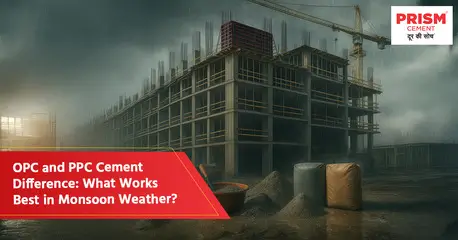When planning your dream home, choosing the right construction cement is as crucial as selecting the perfect design. Among the myriads of building materials available, understanding the OPC and PPC Cement difference can influence the longevity and sustainability of your construction. Here’s a guide for you that can help you through this essential decision-making process.
What is OPC Cement?
Ordinary Portland Cement (OPC) is a widely used building cement, known for its high early strength. It's ideal for projects requiring quick setting and early strength gain, such as high-rise buildings and bridges. OPC is available in several grades, such as 33, 43, and 53, indicating its compressive strength. Its rapid hardening properties make it a preferred choice for time-sensitive constructions.
What is PPC Cement?
Portland Pozzolana Cement (PPC) is a blend of Portland cement and pozzolanic materials such as fly ash. This composition enhances the durability and workability of the cement, making it suitable for general construction, plastering, and masonry work. PPC is recognized for its long-term strength and resistance to chemical attacks, contributing to the long term sustainability of structures.
OPC vs PPC Cement Difference: Environmental Impact Comparison
1. Raw Material Usage
The production of OPC cement involves the extensive use of limestone and other natural resources, leading to higher energy consumption. In contrast, PPC cement incorporates industrial by-products such as fly ash, reducing the reliance on virgin materials and promoting circularity.
2. Carbon Emissions
OPC relies on a significantly higher proportion of clinker compared to PPC. Since the majority of carbon dioxide emissions in cement manufacturing arise during the clinker production stage—primarily from the calcination of limestone—OPC consequently has a substantially higher carbon footprint. In contrast, PPC incorporates pozzolanic materials, such as fly ash, which partially replace clinker, thereby reducing the overall clinker factor and associated CO₂ emissions. This makes PPC a more sustainable alternative, aligning with contemporary efforts to promote environmentally responsible construction practices.
3. Waste Recycling
PPC cement plays a vital role in recycling industrial waste, thereby minimizing environmental hazards. By integrating fly ash into its composition, it not only enhances the cement's properties but also addresses waste management concerns.
OPC vs PPC Cement Difference: Performance and Sustainability Comparison
1. Strength Development
OPC cement offers high early strength, making it suitable for projects where immediate load-bearing capacity is essential. However, PPC cement gains strength gradually, ensuring robust long-term performance and stability.
2. Durability and Longevity
Structures built with PPC cement exhibit superior durability, especially in aggressive environmental conditions. Its resistance to sulfate and chloride attacks makes it ideal for coastal and industrial areas. OPC cement, while strong, may require additional protective measures in such environments.
3. Workability and Finish
The fine particles in PPC cement enhance its workability, allowing for a smoother finish in plastering and masonry work. This property ensures better surface aesthetics and reduces the likelihood of cracks. OPC cement, though workable, may not provide the same level of finish without additives.
Cost and Availability Considerations
In terms of cost, PPC cement is generally more economical than OPC cement, making it a cost-effective choice for large-scale projects. Both types are readily available in the market, but the selection often depends on specific project requirements and environmental considerations.
Conclusion
Choosing the right cement begins with understanding the difference between OPC and PPC. While Ordinary Portland Cement (OPC) is ideal for projects requiring early strength and faster setting, Portland Pozzolana Cement (PPC) offers enhanced durability, workability, and long-term resilience, making it a preferred choice for modern home construction—especially in diverse Indian climates.
At Prism Cement, we’re committed to delivering high quality cement solutions that combine strength, sustainability, and innovation. Prism Champion All Weather Cement is engineered to protect your home from moisture, cracks, and environmental stress—ensuring it stands tall and beautiful for generations.
FAQs
Q1. What is the main OPC and PPC cement difference in terms of environmental impact?
Answer: The primary difference lies in their carbon footprint. OPC relies on a significantly higher proportion of clinker as compared to PPC. Since the majority of carbon dioxide emissions in cement manufacturing arise during the clinker production stage—primarily from the calcination of limestone—OPC consequently has a substantially higher carbon footprint. In contrast, PPC incorporates pozzolanic materials, such as fly ash, which partially replace clinker, thereby reducing the overall clinker factor and associated CO₂ emissions.
Q2. How does the OPC and PPC cement difference affect sustainable construction practices?
Answer: PPC cement supports sustainable construction by recycling industrial waste and lowering carbon emissions. Its use contributes to eco-friendly building practices and long-term environmental conservation.
Q3. Can the OPC and PPC cement difference influence carbon emissions in building projects?
Answer: Yes, choosing PPC cement over OPC cement can significantly reduce the carbon emissions associated with construction, aligning with green building standards and reducing the overall environmental impact.
Q4. Why should eco-conscious builders understand the OPC and PPC cement difference?
Answer: Eco-conscious builders should understand this difference to make informed choices that align with environmental sustainability goals, ensuring that their projects contribute positively to ecological preservation.
Q5. Does the OPC and PPC cement difference impact the durability of green buildings?
Answer: Yes, PPC cement enhances the durability of green buildings by offering better resistance to environmental aggressors, thereby extending the lifespan of structures and reducing maintenance needs.




